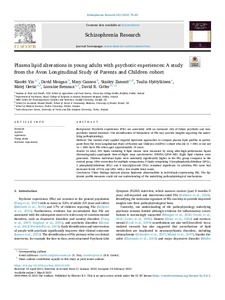Plasma lipid alterations in young adults with psychotic experiences: A study from the Avon Longitudinal Study of Parents and Children cohort
Yin Xiaofei; Mongan David; Cannon Mary; Zammit Stanley; Hyötyläinen Tuulia; Orešič Matej; Brennan Lorraine; Cotter David R
https://urn.fi/URN:NBN:fi-fe2022081155122
Tiivistelmä
Background
Psychotic experiences (PEs) are associated with an increased risk of future psychotic and non-psychotic mental disorders. The identification of biomarkers of PEs may provide insights regarding the underlying pathophysiology.
Methods
The current study applied targeted lipidomic approaches to compare plasma lipid profiles in participants from the Avon Longitudinal Study of Parents and Children (ALSPAC) cohort who did (n = 206) or did not (n = 206) have PEs when aged approximately 24 years.
Results
In total, 202 lipids including 8 lipid classes were measured by using ultra-high-performance liquid chromatography-quadrupole time-of-flight mass spectrometry (UHPLC-QTOF-MS). Eight lipid clusters were generated. Thirteen individual lipids were nominally significantly higher in the PEs group compared to the control group. After correction for multiple comparisons, 9 lipids comprising 3 lysophosphatidylcholines (LPCs), 2 phosphatidylcholines (PCs) and 4 triacylglycerols (TGs) remained significant. In addition, PEs cases had increased levels of TGs and LPCs with a low double bond count.
Conclusions
These findings indicate plasma lipidomic abnormalities in individuals experiencing PEs. The lipidomic profile measures could aid our understanding of the underlying pathophysiological mechanisms.
Kokoelmat
- Rinnakkaistallenteet [27094]
